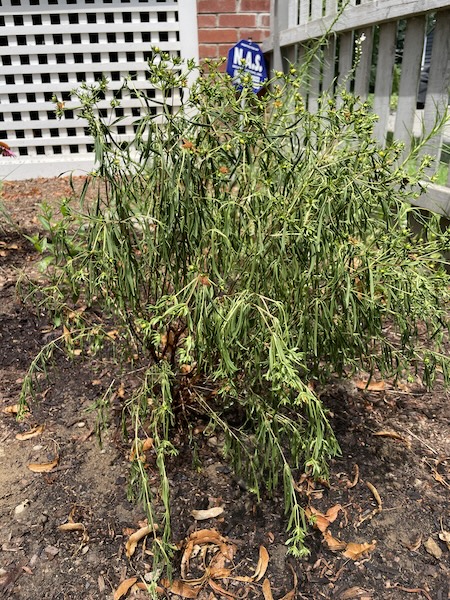Once temperatures soar above the mid-80s, plants are under stress and being pushed beyond their limits. Above 100 degrees and they will start to shut down. As we continue to see rising carbon emissions cause more extreme weather and hotter temperatures, these situations are happening more frequently.
This summer I’ve still been planting. Not huge plots, but the cooler, rainy weather through June made it possible to believe that I could keep going when I typically stop for a bit. I’ve been seeing signs of heat stress on a lot of plants, though, and have paused planting until the weather settles, maybe by the end of August. We’ll see. Not that the heat waves will end, but they’ll be less likely going into fall.
Responses to heat stress
Plants are smart. Because they can’t pick up and move to more suitable surroundings, they conserve their resources during difficult times. Plants focus on survival and will stop or slow their growth. They will curl or roll their leaves to minimize exposure. Fruit, bloom and berry production halts or slows. Crops will have lower yields due to heat, fewer seeds will germinate and seedlings could be stunted.
Signs of heat stress
Sunburn isn’t just a human problem. Scalded leaves look dry, brown and wrinkled. Early last month, I noticed a recently transplanted penstemon in this condition. Although it’s a plant that grows in full sun, it was suffering. The length of time in a pot, its maturity and the shock of transplanting combined to make it more vulnerable. New leaves were sprouting as old leaves were dying off, though. I’m confident it will be fine in the future, just not so pretty this season.
Some plants show heat stress with brown lines or dots on the underside of leaves. Wilting on a hot day means the plant isn’t getting enough water to its stems and leaves, and they droop. Wilting can also be a sign of too much water and too much sunlight, so it’s important to assess all those factors.

I have a few plants in my landscape that droop on hot days but perk up in the evening when it’s cooler. Having observed that cycle, I don’t worry about them. Sometimes monitoring is all that’s needed to understand what the plant is experiencing.
In addition to air temperature, soil temperature and air quality will impact plant health. When the soil heats up, there’s less microbial activity and water retention. Plant roots struggle to take up nutrients. Ozone and wildfire smoke contribute to a plant’s struggles. When all the factors are combined, there will be worse outcomes overall.
What to do
Watering
In general, the younger the plant, the more it is at risk. Watering becomes necessary and more urgent. Always check the soil moisture on hot, dry days.
Vegetables that are working hard to do their job and make a tomato or pepper take more watering and care than a coneflower, for example. Plants that have taproots stretching deep into the soil, like milkweed, will be hardier and less dependent on supplemental water. Plants with roots close to the surface will dry out faster and need more help.
Mulch
A layer of mulch helps stabilize soil temperature during extreme heat or cold. It doesn’t have to be particularly thick, but the type of mulch matters and should be kept away from the stems of plants and the woody trunks of shrubs and trees.
I’ve noticed that shredded mulches tend to become matted and can dry out soil by inhibiting water and air. Fresh wood chips are my choice for moisture retention, weed suppression and adding organic matter to the soil as they decompose.
Tree leaves are a resource on most properties and make great mulch. Shred them using a weed whacker or lawn mower and spread around plants.
Right place
Plants can thrive in any type of soil — clay, sandy, loamy, dry, wet — but they need to be sited for those conditions. The right environment gives plants an edge when they’re under duress.

